#hannah beachler
Explore tagged Tumblr posts
Text















Sinners (2025)
#Sinners#Sinners 2025#Ryan Coogler#Proximity Media#Warner Bros Pictures#vampire film#historical horror#southern gothic#1930s Mississippi#Black cinema#genre-blending film#Michael B. Jordan#Hailee Steinfeld#Miles Caton#Jack O'Connell#Wunmi Mosaku#Jayme Lawson#Omar Benson Miller#Delroy Lindo#Li Jun Li#Lola Kirke#Saul Williams#Andrene Ward-Hammond#Buddy Guy#Zinzi Coogler#Sev Ohanian#Autumn Durald Arkapaw#Michael P. Shawver#Ludwig Göransson#Hannah Beachler
34 notes
·
View notes
Text
Conversation with Sinners Movie Production Designer Hannah Beachler: HBCU Buzz
youtube
17 notes
·
View notes
Text
Sinners will have your head spinning intellectually and literally. Most of all its giving horror/thriller a new lens by way of the amazing Ryan Coogler. https://wp.me/p2v8yf-6Rt #sinnersmovie #sinnerarecoming
#black podcast#Delroy lindo#hailee steinfeld#hannah beachler#horror#jayme lawson#jim crow south#Li Jun Li#Michael B. Jordan#omar miller#podcast#ruth e carter#Ryan Coogler#sinners are coming#sinners movie#southern gothic#thriller#Warner Brother Pictures#wunmi mosaku
11 notes
·
View notes
Text

Empire Magazine (November 2022)
#empire magazine#black panther: wakanda forever#black panther#namor#mcu#movies#Hannah beachler#magazines
12 notes
·
View notes
Text
HANNAH BEACHLER // PRODUCTION DESIGNER
“She is an American production designer. The first African-American to win the Academy Award for Best Production Design, she is known for her Afrofuturist design direction of Marvel Studios film series Black Panther and Black Panther: Wakanda Forever. Beachler has been involved in numerous projects directed by Beyoncé, including Lemonade and Black Is King.”
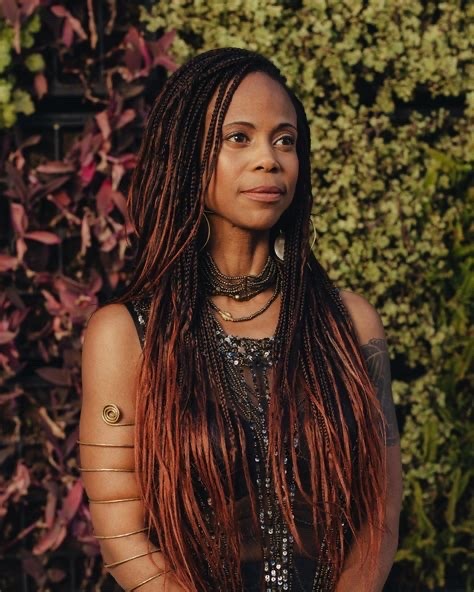

2 notes
·
View notes
Text
Haint Blue and Indigo: The Colors of Annie and Smoke
This is by no means an extensive history of haint blue and indigo*, but I just wanted to dip a bit into how much is said just by looking at one layer of costuming for Sinners. In this case color—how it's able to convey just how deeply rooted Annie is to her heritage/history, and to me, how this case of colors shows so beautifully Smoke's connection to Annie and his love for her.
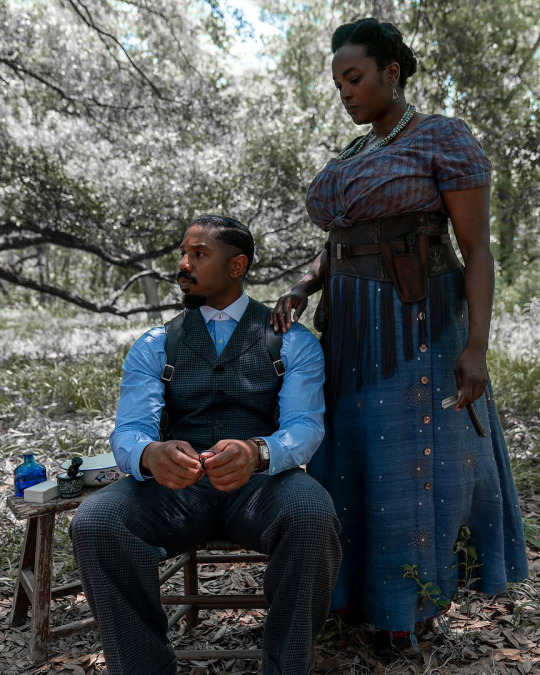

"There's that haint blue that Annie lives around as part of a spiritual color. So I took the haint blue and used it in her clothes. I wanted her to have these layers. You first meet her [...] She's a community person. She's a healer, a spiritual leader." - Ruth E. Carter, Costume Design for Sinners (emphasis mine)
Haint blue is a color seen painted on porches, doorways and windows in the American South. As the name suggests, it was believed (though the oral histories are difficult to come by beyond the 30s), to ward off evil spirits. Using haint blue, according to the Gullah-Geechee, tricked evil spirts into thinking they had come across water or sky, bodies they were unable to cross, therefore deterring them from crossing over the blue.
Annie's costume was infused with this color; the blue on her cotton blouse and her skirt belted with feathers and beads. When we're introduced to Annie, her home has a collection of blues: from the wooden panelling, scraps of fabric hanging in the background, and blue bottles strewn about. This infusion of haint blue in her home is also a deliberate choice as talked about by production designer Hannah Beachler.
*Corrections, whether through comments or reblogs, for this post are definitely welcome! I cite my sources at the end of this long post.
This type of blue is not a specific color but rather, it becomes Haint Blue when it is used for the purpose of warding off haints, a belief rooted in Gullah-Geechee beliefs. (Though for technicalites' sake, it is a range of blues -> blue greens). After the 1800s, this way of using blue trickled down from the Gullah-Geechees in South Carolina to places such Louisina where Annie is suggested to be from.

The Old Plantation (Slaves Dancing on a South Carolina Plantation), ca. 1785-1795. watercolor on paper, attributed to John Rose, Beaufort County, South Carolina
Blue has always had a fraught history with enslaved Native Americans and Africans. The production of indigo was a profitable commodity demanded by the British empire as early as the 18th century. This production of indigo however, while it oppressed, was also a way for Black and Native Americans to express their individuality, and for people such as the Gullah-Geechee, their spirituality. Annie continues to draw strength from her roots and it's incredible to see it so profusely in so many aspects of her character, including her clothes.

So here is where I deviate a bit from "canon" per se, or give some interpretation of Ruth E.'s and Coogler's "Smoke is blue." We talk a lot about how the movie does a great job of showing how, though Smoke wasn't completely "sold" on hoodoo, but that he did very much believe in Annie. And that trust between them goes beyond what Smoke's willing to communicate through words (he wears the mojo bag through the war, through Chicago, and removes it only when he's ready to die. How he let's her take the reigns when talking to Cornbread. How he follows through with his promise as painful as it was).
"Smoke is blue. Stack is red." - Ruth E. Carter explaining how Ryan Coogler first posed the characters to her as a jumping off point for costuming.
Whether or not it's a conscious knowledge, I like to think that he dresses in blue as an extension of that trust. That bond between Annie and Smoke and the protection that comes with it bleeds into something as "ordinary" as Smoke's choice of color. One can say that maybe the color reminds him of Annie, and I also think there's some argument to be made about the universe answering Annie's prayers of protection, wrapping Smoke in an extra layer, another ward against evil.
----
Sources:
Blue Roots by Robert Pickney
Red, White and Black Make Blue: Indigo in the Fabric of Colonial South Carolina Life by Andrea Freeser
Haint Blue, the Ghost-Tricking Color of Southern Homes and Gullah Folktales
What the Color ‘Haint Blue’ Means to the Descendants of Enslaved Africans
Interviews of Ruth E. Carter and Hannah Beachler linked in the pull quotes above.
#again! corrections are very much welcome#i just really love all the ways their love for each other is manifested and how it has a extra branch of reinforcement being grounded#in their historical roots and mutual trust of each other#i love how annie's costume was also put together the way it eventually looked bc of wunmi describing her character's story to ruth e.#smoke x annie#elijah moore#annie#sinners 2025#sinners#long post#history#smoke#annie sinners#smoke sinners#annie x smoke
644 notes
·
View notes
Text
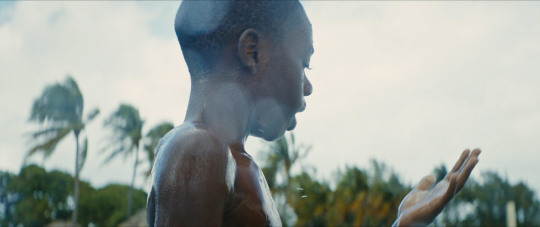




Moonlight (2016)
Director: Barry Jenkins Cinematography: James Laxton Production Design: Hannah Beachler Art Direction: Mabel Barba
#cinematography#film stills#visual storytelling#moonlight#moonlight 2016#barry jenkins#mahershala ali#the absolute visceral loneliness tho
580 notes
·
View notes
Text
3 notes
·
View notes
Note
It's the end of July, so I hope it's OK asking. a Youtuber I know is doing a series about depictions of Atlantis, and of course, wants to talk about Namor. But he's (and I quote) "struggling to find a definitive comic arch or graphic novel to go with." Do you have any suggestions? (I apologize if you've been asked this before, I'm recovering from a sinus infection and don't have the energy to trawl your blog)
Always alright to ask, it's just been taking me some time to reply to stuff so thank you for being patient, I appreciate it. I hope you have recovered from being sick by now and even if you trawled my blog(s) you wouldn't find all the information you needed because I haven't spoken about every aspect of Marvel's Atlantis in depth and I mainly complain and moan about Marvel being stupid and not world building enough. lol. The wiki gives a linear explanation of Atlantis if you need hard facts and summaries but my view on Marvel's Atlantis is that it's a total mess.
As of my current count there are 8 origins/histories of Atlantis. However I'm sure Marvel will squeeze in a few more that make no sense and totally ignore everything that comes before it in the future. I'll discuss the history and different origins further into this post.
That youtuber is struggling to find a definitive arc on Marvel's Atlantis because there is no definitive arc or series of comics about Atlantis, unlike DC's Atlantis Chronicles (1990) which takes time to set up the history of DC's Atlantis in a concentrated mini series, Marvel's Atlantis is literally an afterthought. Even Nate Moore stated how little worldbuilding there is for Marvel's Atlantis.
Black Panther: Wakanda Forever's Producer; Nate Moore; “But in thinking about from a filming standpoint, what’s interesting about publishing is Atlantis feels very Greco-Roman, vaguely drawn, and Namor’s backstory isn’t as interesting as you want it to be. And this is from somebody who’s read all the Namor books. It was like… it doesn’t have the depth that it could have."
I agree and disagree with Moore, while Atlantis's world building severely lacks depth in the comics, Namor's backstory is very original and very interesting. By backstory I literally mean that, his origin story, his mother and father, grandfather and scheming cousins, going to the surface world, meeting the Human Torch, joining the fight against Nazis, etc., if it wasn't so interesting to see then the character wouldn't have endured all these decades. However Moore speaks about Atlantis in this way to explain why they decided to change Atlantis to Talokan, and as you know I'm very pleased with Mcu!Namor & his world, and welcomed those changes because it finally put the work into building Namor's world. Someday I hope we get to see that 400 page Talokan bible that Hannah Beachler created for Wakanda Forever.
As I mentioned in my "Namor was never white to begin with" meta, Atlantis was introduced in Timely/Atlas/Marvel Comics before Aquaman's Silver Age Retcon. However breaking down the creation of Namor and his people goes a long way into explaining why Atlantis wasn't really focused on in Namor's world and why the change in the movies was necessary to bring Namor back to his original non Atlantean origins.
Bill Everett was a nautical enthusiast, and he had a fascination with Antarctica. In Saga of the Sub-Mariner (1988) Roy Thomas wrote several segments that feature Bill Everett's thoughts, and one important factor is that Everett never intended for Namor to be from Altantis to begin with.
It's interesting, then, that you didn't call your submerged world "Atlantis". Everett: No, I didn't want to, because Atlantis to me was another world, a world that existed and I believe it still does, somewhere. I don't think it's alive, but I think the remnants and relics are there somewhere. I think it was a continent that did exist at one time. But the idea of the submerged continent came from Atlantis.
Subby, Bill, & Me by Roy Thomas (Saga of the Sub-Mariner (1988) #5)

So much of Namor's creatioin is drawn from inspiration; Tha-Korr's City (Antarctic Submerged Kingdom) is inspired by the myth of Atlantis. Namor's wings are a nod to the statue of Mercury/Hermes. "Namor" is "Roman" spelled backwards. Sub-Mariner comes from "Rime of the Ancient Mariner" by Samuel Taylor-Coleridge. If you want more of Everett's history/interviews then I recommend reading Saga of the Sub-Mariner (1988), and Fire & Water; Bill Everett, The Sub-Mariner, and the Birth of Marvel Comics by Blake Bell.
Saga of the Sub-Mariner (1988) #8

Namor's underwater world was never meant to be Greco-Roman even though Everett draws inspiration from the idea of it. The Greco-Roman Atlantis of Namor's world was added after Everett left the comics. However it was only truly reinforced and expanded by Jack Kirby and Stan Lee in the Silver Age Fantastic Four comics.
January 1949 - Sub-Mariner Comics (1941) #31 - The first time Namor mentions that he and his people are descendants of Atlantis. In context Namor is telling Betty a Tall Tale about how gravity was invented and makes mention of his ancestors from Atlantis, by the end Betty is left with wondering what was truth or fiction from Namor's story, however this was the only time Namor makes mention of Atlantis in those early years.
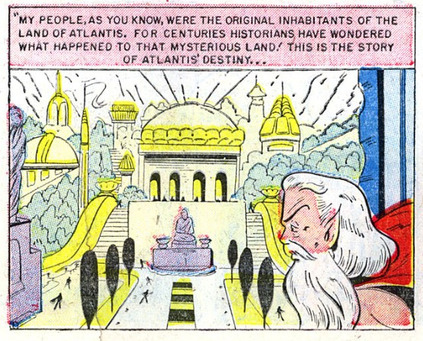
In the Silver Age Namor's world is revamped, the people are no longer green and blue, and whatever colors the printers would decide, now they were a solid blue skinned race of Atlanteans from the lost city of Atlantis that sank during a Great Cataclysm. However if you read the first reappearance of Namor in Fantastic Four (1961) #4 you notice he never says Atlantis, only "My Undersea Kingdom"

Marvel's many Atlantean Origins:
Fantastic Four (1961) Annual 1 we finally get the first origin. Namor, declares to the Fantastic Four that he is from the Empire of Atlantis, and later while Namor is disguised as a human scientist, he tells the world the origin of Atlantis, about his father and mother, and his own birth.
Origin #1: The Atlanteans were a sub-sea race of homo-mermanus, nomads who were born and lived in the sea, and they developed as surface nations do, they settled, built great cities, their people developed and created sciences and weapons, etc. They were a Myth to the surface world.
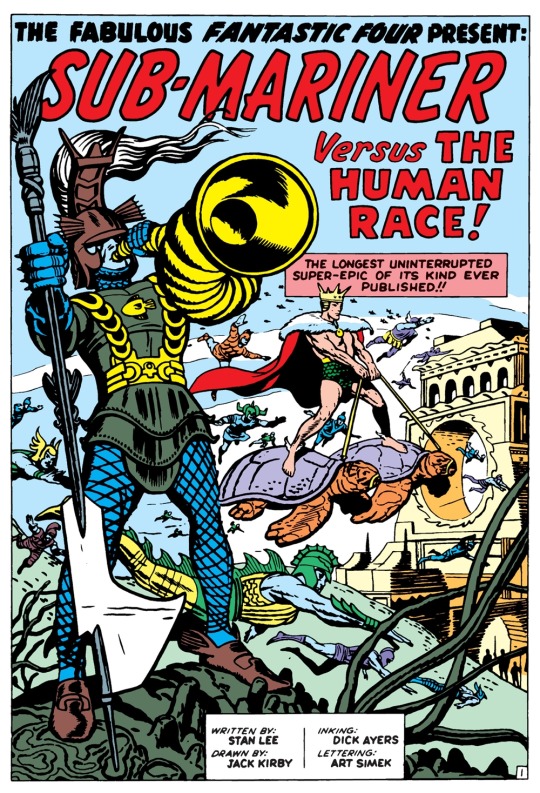

As Namor's stories continue in Tales to Astonish and The Sub-Mariner, you see the cities are built and the Atlanteans are all dressed as an undersea fantasy Greco-Roman style, they worship Neptune as their god, and speak in a very archaic manner.
In the 70's Bill Everett came back to work on Namor comics in The Sub-Mariner series, however he was struggled with his health due to his life long alcohol addiction, he had quit drinking years ago but his health continued to decline until his death in 1973, and because he was working on Namor comics at the time he wasn't able to complete the required number of pages Marvel wanted, so after the main story Marvel had small mini stories of Namor's youth, and a later a segment called "Tales of Atlantis".
The Sub-Mariner (1968) #62-66
Origin #2: Atlantis was a Island Nation that was caught up in a war with Lemuria, the Deviants & Celestials, which leads to their country sinking into the sea, where later a young water breathing warrior stumbles across the lost city of Atlantis. The warrior has a vision of what Atlantis was, and what it will be, and then decides to go back to his people, the homo-mermanus, and make them give up their nomadic ways to settle in the sunken city and create an empire.

Now this is where things get confusing and never stop being confusing for any fan of Namor's comics. Why? Because Marvel does not have all of the Atlantean History in a neat and tidy comic series like DC does, every instance of Atlantis and its history is split up among several comics series and books, and Marvel confuses things further by including Conan's Era, the Hyborian Age, which is meant to be in very distant past and they have Namor's Atlantis be of that Atlantis and there's Celestials, and Deviants, and Lemurians, and Amazons and on and on. It's a soup of "whatever" thrown in.
This would confuse any reader because so much of the Atlantean history is contradictory. No reader is going to know they need to read Conan to get a backstory on Atlantis before the Fall (The Great Cataclysm). No reader is going to care about the Space War between the Celestials and the Deviants or the Lemurian Deviants, or care about the copy/paste Lemuria which is just Atlantis but in the Pacific Ocean and it sank at the same time as Atlantis did. No reader is going to follow every comic to get the full picture. If we just read Namor comics its confusing enough, let alone adding in more. Not to mention Marvel's additional Marvel Universe books. It's safe to say from now that Atlantis is an afterthought and made up of a patchwork of stories over decades where no one cared about continuity or sense.
After all how is it we went from an evolved sea people to a island continent people who's city fell into the sea and then is found by those same sea people and the warrior is the spirit son of the fallen king and queen. See how confusing that is? But wait, it gets worse.
Saga of the Sub-Mariner (1988) #1
Origin #3: Now it's Deviant Lemuria who challenged the Celestials who punished the Lemurians, and Atlantis is caught up in the crossfire of that war. This origin follows the Tales of Atlantis origin.
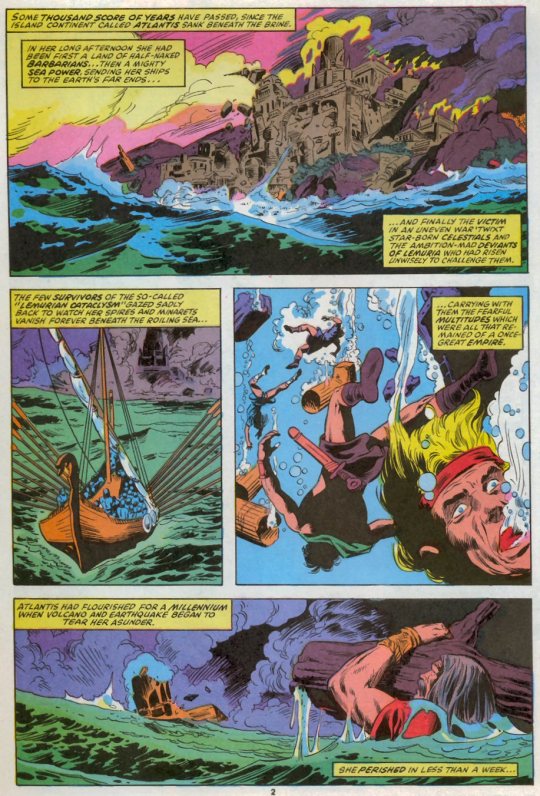
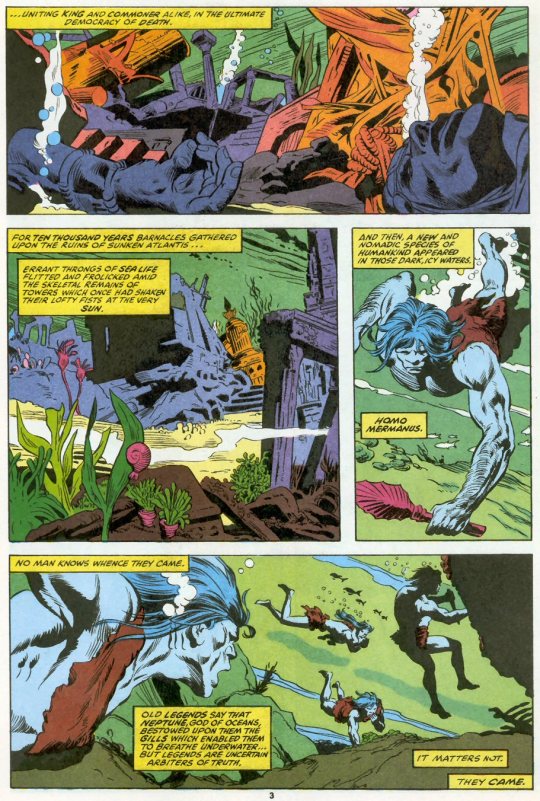
This next origin goes more into detail between the Elder Gods, the war between the Celestials & the Deviants, and Lemuria. The important thing to note about this next one is that this is the first major Crossover Event to happen at Marvel comics, by crossover event I mean a comic event that spans several different comic series/characters and this is a very confusing, long winded series, thats is found in the Annuals of different comics, however it does touch on the Atlantean Origin.
Atlantis Attacks/Atlantis Rising (1989-1995)
Origin #4: The War between the Celestials & the Deviants cause Atlantis to fall into the sea. Uncanny X-Men (1963) Annual 13

During this event Morgan Le Fay raises the sunken Atlantis from the Sea and claims that it's actually Avalon, because in Namor, the Sub-Mariner (1990) #62 one of Namor's ancestors comes to him a vision and tells him that all of Atlantis didn't fall into sea and there still scattered islands left around. Later the island of Atlantis sinks into the sea as well.
So as you can see, the origins are just a tower of unstable blocks, every writer comes along and adds something to it. Now its not just Atlantis, Atlantis is also Avalon. Why. Why does Atlantis need to also be Avalon, why must they be connected at all? I think this got retconned later but I honestly don't care to find out.

Now this next one is my favorite origin and imo the one that is uniquely Namor's. It's written by J.M Dematteis and drawn by Liam Sharp. Firstly I regard this as the best Atlantean origin because Namor is directly involved, it's an interesting and original take on Atlantis, it brings in so much lore and artifacts in such a short amount of time and it has Cleito who is Neptune's wife as a goddess whom Namor worships as well. Namor's destiny is tied to Atlantis, and this is the first time we actually see him interacting with his destiny as a Son of Atlantis, it's Avenger, it's Protector.
Secondly, anytime Marvel uses Atlantis in the shared Marvel Universe, they twist it to fit whatever comic they are using it in. In Conan comics, in Hercules comics, etc. there are different stories, and while comics are very confusing, its worse when other characters comics are involved. I personally feel that Marvel tried to make Atlantis's history as linear as possible and just cram in all the origins/history but it doesn't work, you can read the wiki for different Atlantean Ages but for me, if it isn't directly tied to Namor then it means nothing. I'm here for Namor. I'm here for Namor's Atlantis. Which is why this Origin is what I consider to be the true origin because Namor is a big factor in it.
Man-Thing (1997) #7-8
Origin #5: Namor has a vision to seek out Man-Thing, who guides Namor to the lost City of the Golden Gate to retrieve & restore the Nexus Fragment. Here we learn that Atlantis was not one country or one Island Nation, but it was an Empire made up of Ten Kingdoms and had Ten Kings of Atlantis. Cleito is the Divine Mother, wife of Neptune/Poseidon (In the comics Neptune/Poseidon are interchangeable, they are they same character who is called by both names, because Atlantis is a Greco-Roman mash up.). Evenor (seahorse looking deity) is the Guardian God. Here we learn that the City of the Golden Gate was the capital of the Altantean Empire. It currently exists both in and out of time.
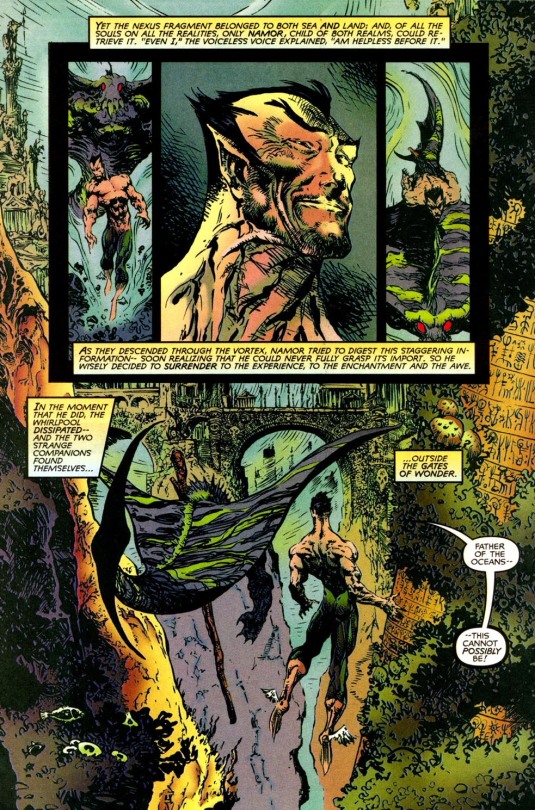
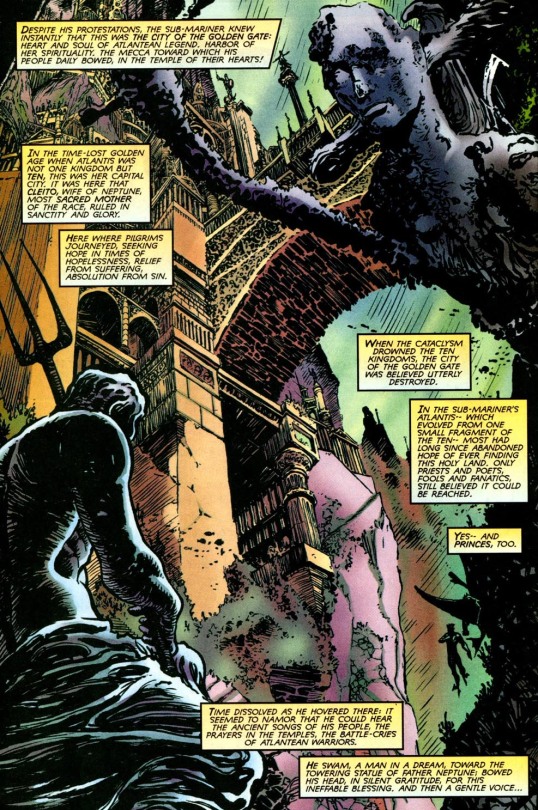
Namor is then taken into the past, to the capital city in it's prime, sees Atlantis in her Golden Age, and meets with his goddess, Cleito. She tells Namor: "Come forward Namor, and accept the coveted stone that only the Child of Earth and Sea may receive." Namor is given the Nexus Fragment and hears Cleito's words of wisdom, love, and praise.
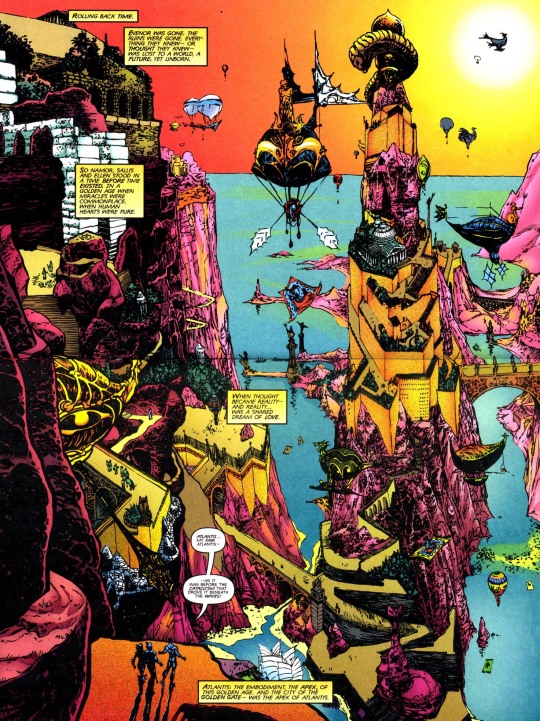

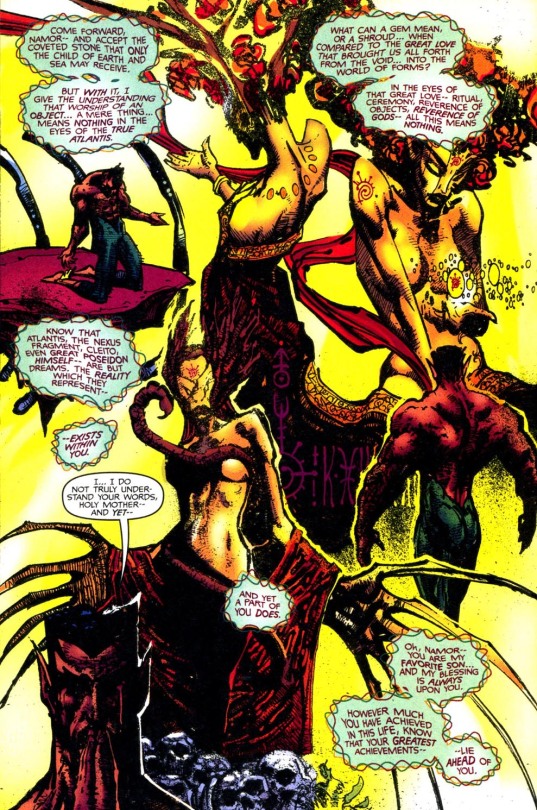
Then Namor witnesses the Great Cataclysm, the Fall of the Ten Kingdoms of Atlantis, and sees his people drown in the sea.

All throughout Namor's comics we are told that Namor has a Great Destiny, that he is destined for something, destined to save Atlantis, to save the Seas, to save the Surface World. However in all of the other origins or even in Namor's other comics we do not get any further information of that Great Destiny, except in these two comics we get so much Lore & History; Namor witnesses his Ancestors downfall, and meets his goddess, and for the first time I actually felt that Namor is special. I really love this story and personally I feel this is the best arc for an Atlantean Origin because as I said before Namor is essential to the story, and that's why this story is valuable for his Atlantean Origin. There is more details in the comics, they talk about other artifacts like a Shroud, the past kings/people of Atlantis, etc.
Inhumans (1998)
Origin #6: Triton claims that the Inhumans and the Atlanteans are cousins. Atlantis that was risen by Morgan Le Fay is now home of the Inhumans, Attilan. Inhumans (1998) #9 I don't know or care when the Inhumans and Atlantean cousin origin started and it might have just been mentioned in this series.
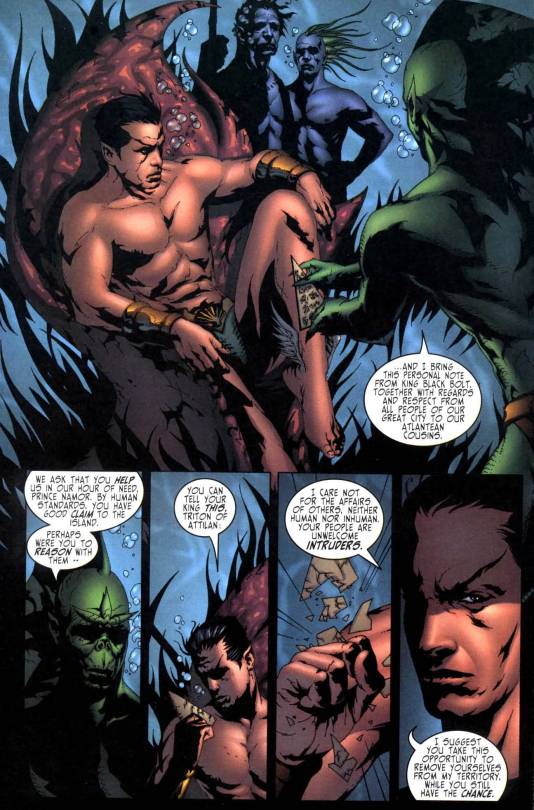
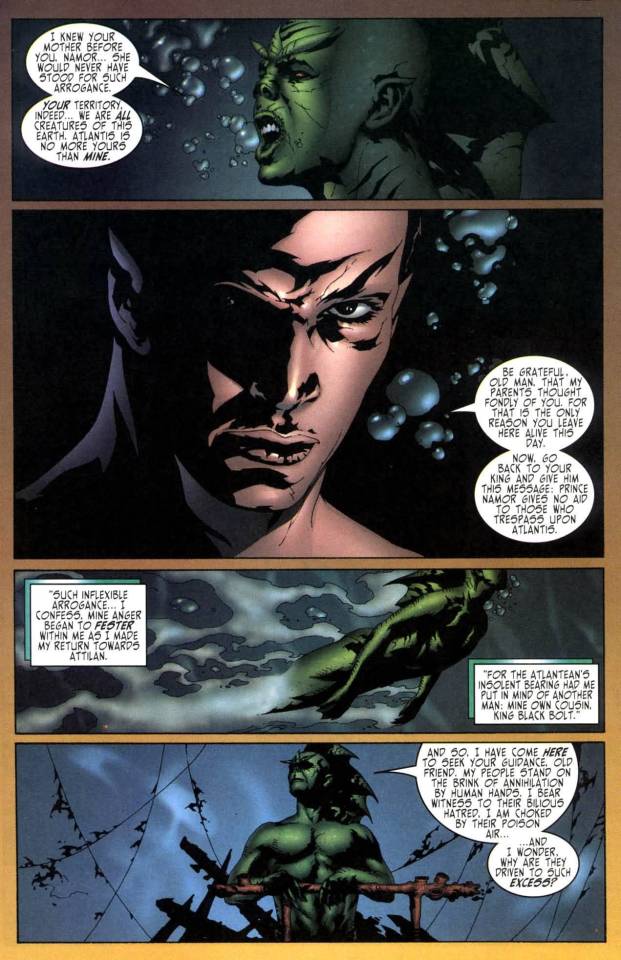
And why not, why isn't Atlantis also Avalon and connected to Attilan, at this point I'm just waiting to make sure Atlantis isn't also Asgard as well. /sarcasm. Marvel, we do not need every magical/superhuman place to also be Atlantis. Anyways we aren't done yet.
The Incredible Hercules (2008) #123
Origin #7: The Atlanteans hired Amazons to slay Gorgons for them, instead of paying them their due for their work they killed some of them, and used magic to try and protect themselves from the Amazons retaliation, however the magic was too strong for them so as Atlantis sank into the sea they used their magic to turn their people into water breathers.
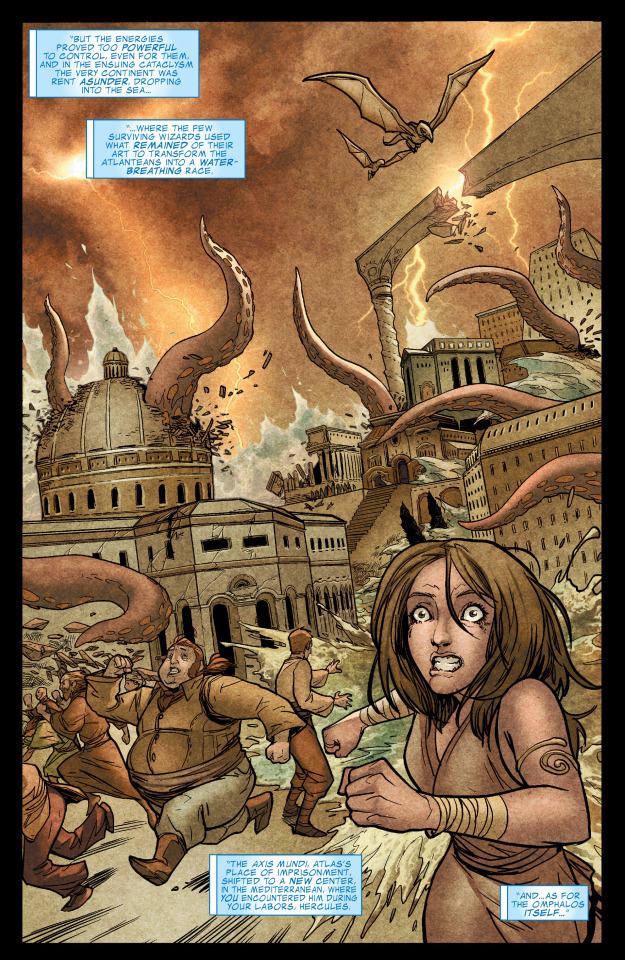
Finally we come to the final Atlantean Origin.
Namor: The Best Defense (2018)
Origin #8: Namor travels through tunnels and is transported to a world of water, where the Vodani live. On Vodan he meets the king and his daughter, the princess, and attempts to get them to rejoin their people with the Atlanteans. The Vodan King sets Namor to a test, kill a giant beast, when Namor and the princess do so the King still refuses to join with Namor and attempts to kill him while informing him that all Atlanteans are descended from Vodan. That Vodan is the true homeworld of the Atlanteans.
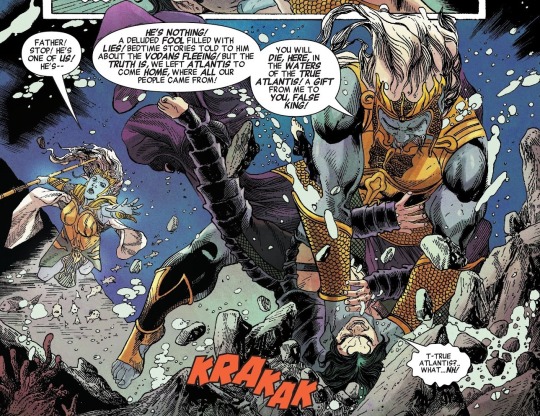
This origin is my most hated because it goes against everything that I believe Atlantis should be set in. 1. It makes Atlanteans space aliens. I hate that. I hate Atlantis being connected with space stuff. 2. It flies in the face of what Everett intended Namor to be, he wanted Namor to be the opposite of Superman, superman came from another planet so he had Namor be from Earth. By making the Atlanteans from Vodan it severs the last tie Namor has to Earth. After all if Vodan is so great and its a entire world made of water where the Vodani are so safe then what's to stop the Atlanteans from simply returning to their home world? In the comics Atlantis is constantly destroyed by events, and enemies, and bombs, and poisons, so why would they rebuild Atlantis over and over and over again? I just really really hate anything Atlantis being "Space Aliens". I also hate the Celestial & Deviant Lemuria war origin, and I hate the Amazon origin, I dislike the Spirit Son origin too, because in the end it over complicates and doesn't add anything to Namor's Lore.
Throughout the years Marvel has handbooks that explain Atlantis.
The Official Handbook of the Marvel Universe Deluxe Edition (1985) #1 - Basically outlines Origins # 2, 3, 4
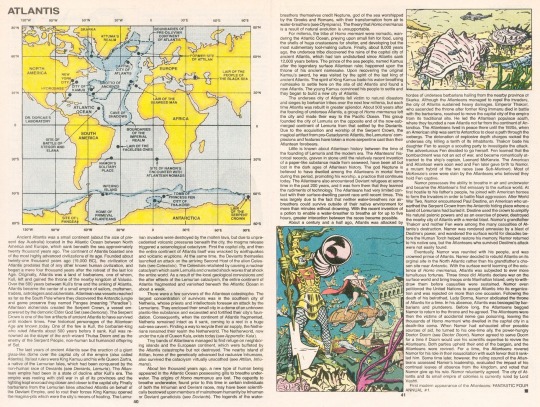
History of the Marvel Universe (2019) #1 - This Origin also goes along with the Celestial and The Great Cataclysm origins but once again Atlantis is caught in the crossfire of the Lemuria war, and this time Atlanteans somehow survived and Adapted to become water breathers. This differs from the origins of 2, 3, 4 where it says that a race of water breathers were already there but this is also different than origin 7 where magic was used to change the Atlanteans.
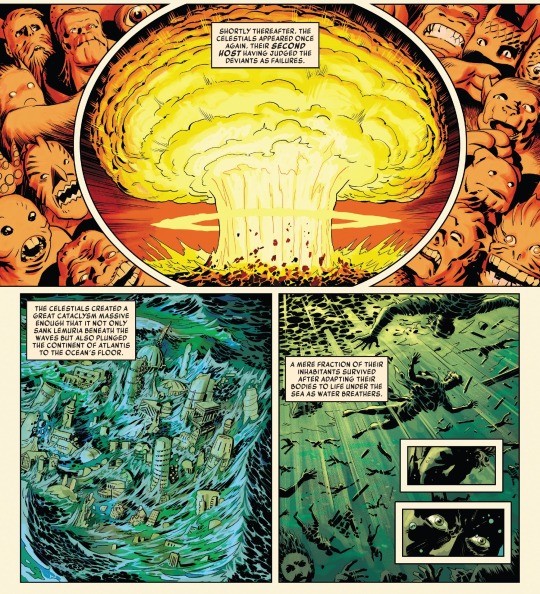
Now stories about Atlantis that take place in Atlantis are found in Namor's books, mostly the Silver Age gives the most focus with an Atlantean setting. However many of those plots are the same, Attuma attacks Atlantis, Namor and friends save the day. Krang betrays Atlantis, Namor saves the day. Some other threat comes up and Namor- you get it, he saves the day. Even Atlantis Attacks both the first and second series that have that name do not focus on Atlantis itself. You find some comics have short panels or issues that mention Atlantean History (events that happened after the Great Cataclysm) such as Emperor Thallo outlawing all clones/the cloning process (Namor, the Sub-Mariner (1990) #20). Or Namor having a very bad time in hell (Namor: The First Mutant (2010) #6-7) and speaking with dead Atlanteans rulers like Empress Rithea. We get Namor's childhood in Atlantis as he grows up but to wrap up this already long post about Atlantis; There is no definitive origin. There is no definitive arc, except for one that I actually feel is a comic arc worth reading if people want a good Atlantis storyline.
Suma-Ket & Artys-Gran - Namor, the Sub-Mariner (1990) #30-40
The Suma-Ket Arc begins in issue 30, with Namor, having lost his memories (again) is found by Doctor Doom, who also finds a woman who looks like and claims to be Princess Fen, Namor's long dead mother. As the arc proceeds the readers are drawn into a dark high fantasy story about Suma-Ket, the Prophet King of Ancient Atlantis. Before Namor's time, and before the time of his grandfather, and many before that. Suma-Ket came to "save" Atlantis from the Faceless Ones, demons with no faces, and the people welcomed him not knowing he probably sent the Faceless Ones himself so he could have a foothold into Atlantis. Over time he and his wife, Artys-Gran, overthrew their king and took control of Atlantis and its people. Both of them were sorcerers, Suma-Ket was a Necromancer who could command the Unforgiven Dead, and Artys-Gran was a Bodysnatcher, trading her mummified body for the body of whomever she chose. They slaughtered Atlantean children in their blood rituals, and ruled Atlantis through death and fear. They used blood magic to try and open the gates of the Demonic Elder gods, and needed royal Atlantean blood to do so. Both were banished along with all their loyal servants centuries ago but they return in issue 36 to take Atlantis once more. The art is harsh, but very compelling and I really love this story arc. Suma-Ket arrives in issue 36.

King in Black: Namor (2020) #1-5
This is another series that has a great Atlantean arc, and it's set during Namor's childhood with flashbacks to the present day. I really love this series and can't recommend it enough.
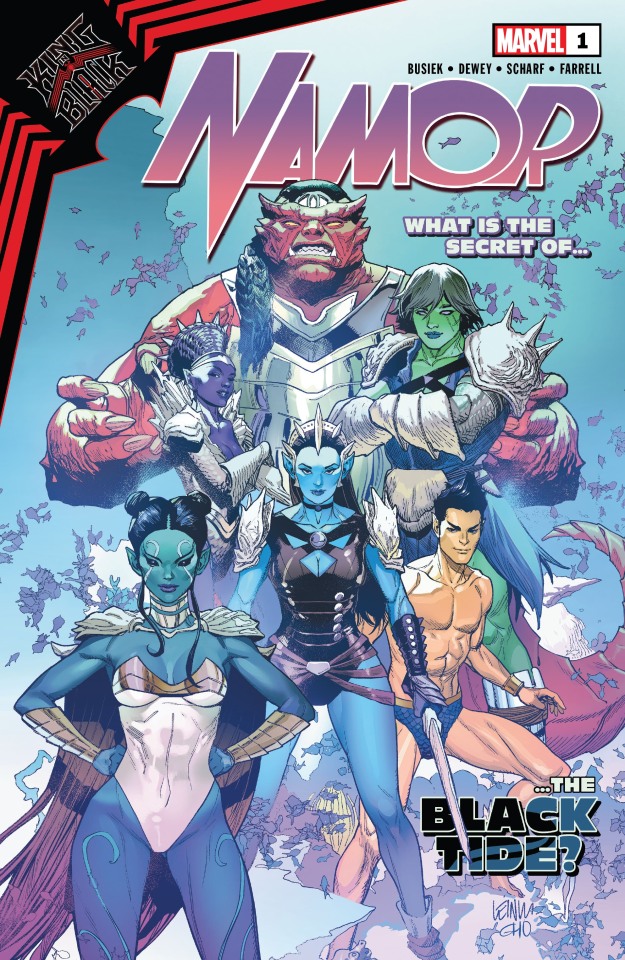
As you know, I love Namor and his world, but I personally feel that Namor's story is more about his character, navigating through two worlds, whose people are a minority and their homes were taken from them. Which is why I'm very pleased with Namor's Greco-Roman Atlantis being brought back to what it originally was, a isolated sub sea nation that sought to protect themselves from the surface world. That's why the Mesoamerican influence works with Mcu!Namor, and why I really feel that we haven't lost anything due to the changes to Talokan when Marvel Comics themselves never really put in an effort for a clear and concentrated Atlantean Worldbuilding.
Anyways, I hope this very long post helps explain things and if you want to check out my art commission of Namor and who I consider to be his Atlantean gods, enemies, and allies then I will link it, and I also commissioned a Talokan art. ( Atlantis / Talokan )
#namor#namor mckenzie#namor the sub mariner#mcu namor#atlantis#talokan#marvel comics#comic meta#imp answers#long post
19 notes
·
View notes
Text
Neptune Frost (2021)
"One who swallows a whole coconut trusts his anus."
Neptune Frost is an afro-futuristic film from Rwanda. This was the first film from Africa that we watched for this class. It’s cybernetic costumes, hair and make-up make it feel like a music video. The technology in this movie is incorporated into the environment. The trees, houses and even the people have circuitry built in. It reminded me of Hannah Beachler’s production design from Black Panther in the capital city of Wakanda. In her design, Beachler allowed the natural landscape of the country to dictate the city layout. What I love about afro-futurism and solarpunk is the brightness and optimism that it conjures. In contrast to the dystopian visuals of cyberpunk that we see in Blade Runner or, well…Cyberpunk. If this is the only future that we can visualize or have reference for, it can become easy to give into despair and cynicism and think that we are doomed to the worst possible version of the future. A future where corporate greed has stripped away every aspect of our humanity including our ability to fight back. Afro-futurism imagines a future that not only includes black people but where we thrive and reclaim agency from outside imperial forces. We have to be able to imagine better if we want to make a better future.
The film takes place in a city made of computers, not far from a coltan mine. In the opening scene, the brother of one of the miners, Matalusa, is killed by mine security. Another central character, the titular Neptune, is a runaway who joins Matalusa’s revolutionary collective, “Unanimous Goldmine”.
Neptune is an intersex technopath who is able to use their abilities to bring people into the collective across dimensions and time.
I was pleasantly surprised by the amount of queerness in this film. Not only is there an intersex lead but everyone in the Unanimous Goldmine collective presents in a way that wouldn’t be out of place at a Pride march. It’s more progressive than I would have expected from an African film and pushes back against the idea that all Africa is inherently homophobic. While homophobia and homophobic violence is a very real problem across the motherland, queer and trans people still exist there and deserve to be seen and loved like anyone else.
0 notes
Text
ON-SET PRODUCTION READING
SET DECORATORS SOCIETY OF AMERICA - MOONLIGHT
SET DECORATOR: Regina Crowley SDSA PRODUCTION DESIGNER: Hannah Beachler A24
Beachler was a set decorator before becoming a production designer and learned to get thrifty and resourceful which came in handy for this smaller budget film - one way she influenced the look of the film on a budget was through colour, which is one of the most memorable elements of moonlight.
Discussions centred around the colour story, backstories, mood and nuance - what the characters liked and possessed. With the limited budget, there was no room for error or second choices, every purchase was used and there no extras. That required great teamwork and communication.
CHIRON'S FIRST HOME

Chiron lived with him mother, Paula, who was struggling with substance abuse.
Their home was a one bedroom with the sense of a single mum 'trying to make ends meet... but there's a sense of comfort, safety and possibilities. And then, slowly we start taking that away.' I remember noticing this myself when watching it and I thought it was a brilliant method of exposition. Only once I believe, this is properly addressed, when Paula sells the TV and Chiron is upset about it. Otherwise, possessions just disappear throughout the film and you can assume that they're being sold to make money to buy drugs. As well as this, the home becomes dirtier, with unfolded clothes and unwashed dishes piling up.
CHIRON'S SECOND HOME
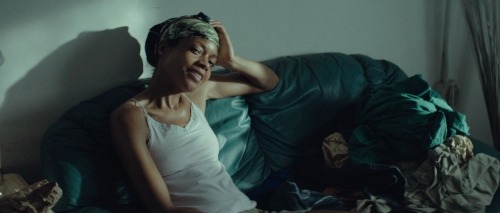
This location was found with some great research. It was in the heart of the Liberty City Miami projects (Pork n' Beans) - known for housing welfare-dependant single mothers from the 1960s-80s. The idea was to make it resemble what a home should be - kitchen, bedroom etc - but with a 'duplicity' as its a neglected home. Even though Chiron finally has a bed to sleep in, there's no sense of home.
They often filmed on location and interesting parameters came with it - they were the first public housing projects for African Americans in the Southern US. They made the house dingy, with dead roaches and a picture of Jesus on the wall. This reflects how Paula lost the will for anything other than the next fix, the home became just a place to sleep in.
The colours became dark and dreary, even visible from the two screen grabs above.
JUAN AND TERESA'S
The only solace Chiron had was Juan and Teresa's house, Juan being the local dealer who took Chiron in.

The colours here and bright and cheery. The windows let in light and the house is surrounded by and contains a lot of plants - a sign of life. This was Chiron's real home and yet he still always felt like an imposter in it.
THE BEACH

The colours and light here, similar to Juan and Teresa's are so bright that it's almost disorientating. The beach is a place of clarity for Chiron. It is his safe place. The only place he feels at home.
The film was based on Tarell McCraney's, IN MOONLIGHT BLACK BOYS LOOK BLUE. Crowley said, 'The imagery of the moonlight gave us a sense of melancholy which we played off of in the use of the color blue. That was Little/Chiron/Black’s world. Cool, aloof, disconnected. The brighter colors were in the ‘real’ world—the world our character has no control over and feels misunderstood and apart from. The crossover spaces have a combination of both.' 'All of the exteriors—Paula’s apartments as well as Black’s [adult Chiron], the streets, school, playground, abandoned buildings and barren open spaces—are the tough, unyielding world where our character is vulnerable,' says Crowley. 'The only safe place is Juan & Teresa’s house. And the beach in the moonlight.'

1 note
·
View note
Text
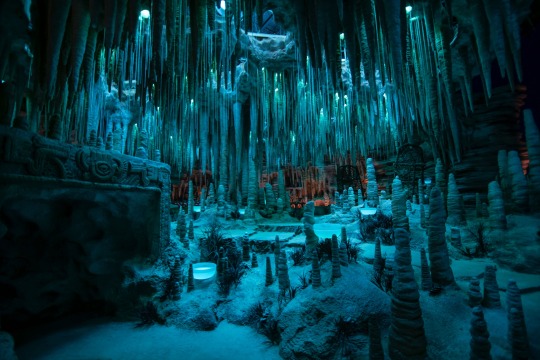
The set build. Over 300 hand carved, stalagmites and stalactites. The entire set was carved. The Feathered Serpent.
Art Director: Jason Clark
This set inspired by the Ceiba tree, sacred tree of life and the three realms, which Namor occupied all, like Chaac guardian of the underworld. The story of Chaac is intricate, a beneficent entity related to agriculture production and to life.
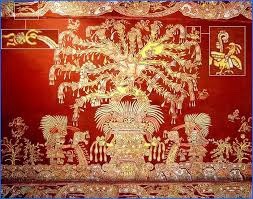
As much love and thought to Talokan as to Wakanda, this...is just the beginning of this new world.
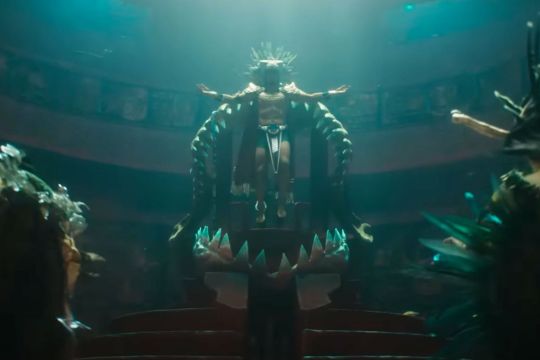
Namor's throne seat. A Magalodon jaw with Jade Teeth. The Hieroglyph carved in the bone reads, "This Jade Tooth Bites." I thought it was charming and dangerous like Namor. The piece was 12 feet tall by 10 feet wide. It was BIG!

The feathered serpent. From El templo, the Temple of Kukulcán. aka El Castillo, Chichen Itza. The temple has 91 steps on each side and including the platform is 365. Master Engineers, it would be pre-columbian Maya.

We wanted to have the Feathered serpents presence in Namor's place of peace and remembrance. You would not have seen it in the film but it was important for me that its presence was felt.
My motto, as little CGI as possible. I fought and pushed to build build build! Wherever possible, it's a set.
- Hannah Beachler, Black Panther: Wakanda Forever Production Designer, Academy Award Winner
#black panther: wakanda forever#behind the scenes#mcu namor#photography#set design#hannah beachler#talokan
614 notes
·
View notes
Text
Monday MCU
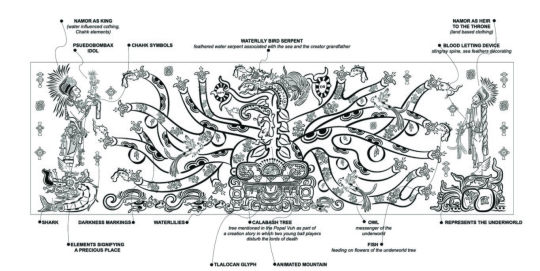
by graphic artist Kelsey Brennan
Namor's cenote mural of the establishment of Talokan
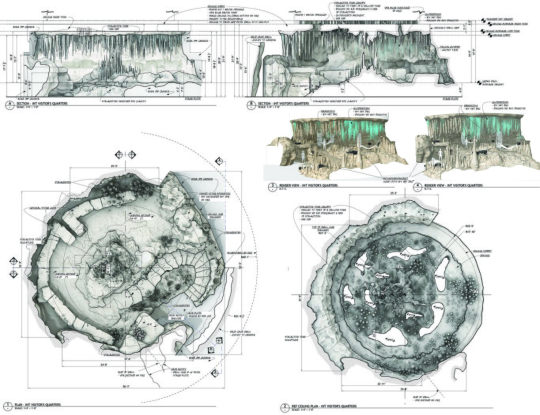
by Tim Croshaw
Visitor's quarters cenote, plans and elevations.

by Tim Croshaw
Namor's cenote plan

by Peter Rubin
Namor's throne room backdrop, digital model.
"Memory as form is in essence the translation of emotions. Talokan is Namor’s memorial of the world he once knew at the end of its reign. The greatness he knew of Maya was from oral stories and written records and manuscripts such as the Codices and the Popol Vuh. Through Namor’s quest in memorializing Maya, the originality of Talokan became material. The architecture of Talokan is the physicality of memory, which lies in the gestures the structures adopted, while also managing the provocation of thought about the life and purpose of the structure itself, and care over the architectural spectacle. Spaces appear detached from both structural soundness and reality. Beyond merely shape and color, this world had to embrace the lack of a sense of direction and gravity. It encapsulated the illusion of suspension, a connection to environment, contemplation over stability and symmetry. For some, the more separated in time you are from a memory, the more subjective it becomes, and so the creative team followed this in form and structure." -- Hannah Beachler
This is all from a great article by the art director for Wakanda Forever, Hannah Beachler, for PERSPECTIVE The Journal of the Art Director's Guild.
Source
#Namor#Sub-Mariner#MCU Namor#Monday#Monday MCU#Talokan#Wakanda Forever#Hannah Beachler#Blueprints#Article#Behind the Scenes#Tim Croshaw#Peter Rubin#Kelsey Brennan#MCU#Art Design
89 notes
·
View notes
Text
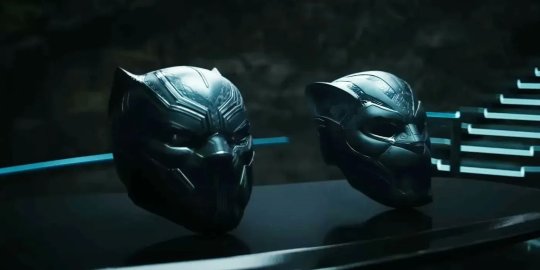
When Shuri picks her Black Panther helmet, she walks by T'Chaka and T'Challa's helmet and chooses hers, her destiny. But they are there with her, holding her up and giving her strength. - Hannah Beachler
63 notes
·
View notes
Text
no one: how are you feeling today?
me: you know, still mad that hannah beachler didn't get a nomination for her production design in wakanda forever, you?
#production designer#production design#academy awards#oscars#hannah beachler#black panther: wakanda forever
29 notes
·
View notes